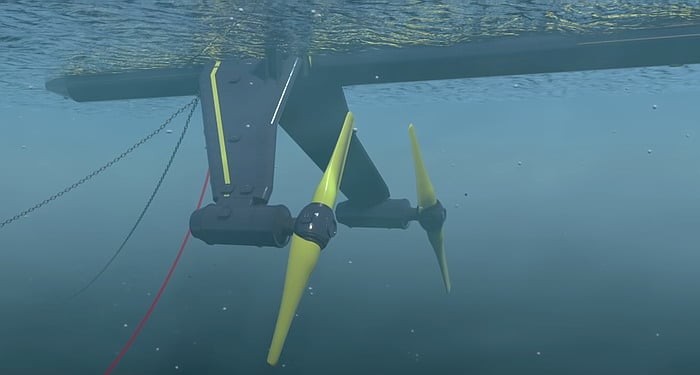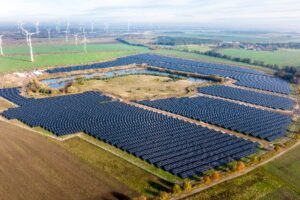What is Tidal Energy?

Along with the other sources of clean power available on planet Earth, tidal energy can be used as a green alternative to fossil fuels.
Tidal Energy Definition
Tidal energy, also known as marine energy, is a form of renewable energy that harnesses the power of ocean tides to generate clean electricity. The tides are caused by the gravitational forces of the moon and the sun on the Earth’s oceans, resulting in a continuous cycle of rising and falling sea levels. Tidal energy has great potential as a source of clean and sustainable energy, and it is rapidly gaining popularity around the world.
How Tidal Energy Works?
Tidal energy is generated by using turbines that are placed in the path of the moving water. These turbines are similar to wind turbines, but instead of being powered by wind, they are powered by the flow of water. As the tides come in and out, the turbines are rotated, which generates electricity.
There are two main types of tidal energy systems: tidal barrages and tidal turbines. Tidal barrages are large dams that are built across estuaries or other areas with high tidal ranges. The barrage has sluice gates that are opened and closed to allow water to flow through turbines, generating electricity.
Tidal turbines, on the other hand, are similar to wind turbines and are typically located in underwater currents. These turbines are anchored to the seabed and have rotors that are turned by the flow of water. Tidal turbines can be installed individually or in arrays, depending on the size of the project.
Advantages of Tidal Energy
Being a clean and renewable source of power, tidal energy has many advantages.
Is A Clean and Renewable Source of Energy
One of the main advantages of tidal energy is that it is a clean and renewable source of energy. Unlike fossil fuels, tidal energy does not produce greenhouse gas emissions or other pollutants, making it an environmentally friendly option. Additionally, tidal energy is predictable and consistent, as the tides follow a regular pattern that can be predicted with a high degree of accuracy.
Low Operating Cost
Another advantage of tidal energy is that it has a very low operating cost once the initial infrastructure is in place. Unlike fossil fuel power plants, which require a constant supply of fuel, tidal energy plants can generate electricity without any ongoing costs once they are constructed.
A Reliable Source of Energy
Tidal energy is a reliable source of energy, as it is not affected by weather conditions like wind and solar power. The tides are predictable and consistent, which makes it easier to plan for energy production and ensure a steady supply of electricity. This reliability is particularly important for areas that rely on a constant supply of energy.
Predictable and Consistent
Another advantage of tidal energy is that it is predictable and consistent. Unlike other renewable energy sources like wind and solar power, the tides are predictable and follow a regular pattern that can be forecasted with a high degree of accuracy. This makes it easier to plan for energy production and ensure a steady supply of electricity.
High Energy Density
Tidal energy has a very high energy density, which means that it can generate a lot of power from a relatively small area. This is because the water in the tides is much denser than air, which means that it can turn turbines more efficiently than wind turbines.
Potential for Local Generation
Tidal energy has the potential to be generated locally, which means that it can provide a source of energy for remote areas that are not connected to the national grid. This can help to reduce reliance on fossil fuels and increase energy independence.
Challenges of Tidal Energy
The main disadvantage of tidal energy is represented by its impact on marine life.

Installing a new tidal turbine less harmful for marine life, image source: Pixabay
High Capital Cost
One of the main disadvantages of tidal energy is its high capital cost. Building a tidal power plant requires significant investment in infrastructure, including turbines, generators, and other equipment. The cost of constructing a tidal power plant can be significantly higher than other forms of renewable energy, such as wind and solar power. This makes tidal energy a less viable option for developing countries or regions with limited financial resources.
Limited Availability
Tidal energy is only available in coastal regions that have strong tidal currents. This means that not all regions of the world can benefit from this source of energy. Additionally, the availability of tidal energy can be affected by factors such as changes in the moon’s orbit and sea level rise, which can reduce the strength of tidal currents and limit the amount of energy that can be generated.
Environmental Impact
The construction of tidal power plants can have a significant environmental impact, particularly on marine ecosystems. Tidal turbines and other infrastructure can disrupt the movement of marine organisms and disrupt the natural flow of water, potentially impacting marine life and ecosystems. Additionally, the extraction of energy from tidal currents can alter water temperatures and nutrient concentrations, affecting the growth and survival of marine organisms.
Maintenance Costs
Tidal power plants require regular maintenance and repair, which can be costly and time-consuming. The harsh marine environment can cause damage to equipment, and repairs often require specialized tools and expertise. These maintenance costs can add significantly to the overall cost of tidal energy production.
Grid Connection
Tidal energy plants must be connected to the national grid to distribute the electricity they generate. This can be a challenge in remote coastal regions where the grid infrastructure may not exist or may be insufficient to handle the power generated by the plant. Building new transmission lines to connect the tidal power plant to the grid can add significantly to the overall cost of the project.
Conclusion
Tidal energy is a promising source of clean and renewable energy that has the potential to play a significant role in meeting the world’s energy needs. While there are some challenges that must be addressed, such as the high cost of infrastructure and potential impacts on marine life, the benefits of tidal energy make it a viable option for the future. With continued research and development, tidal energy could become a major contributor to the world’s energy mix, providing a sustainable and reliable source of electricity for generations to come.







